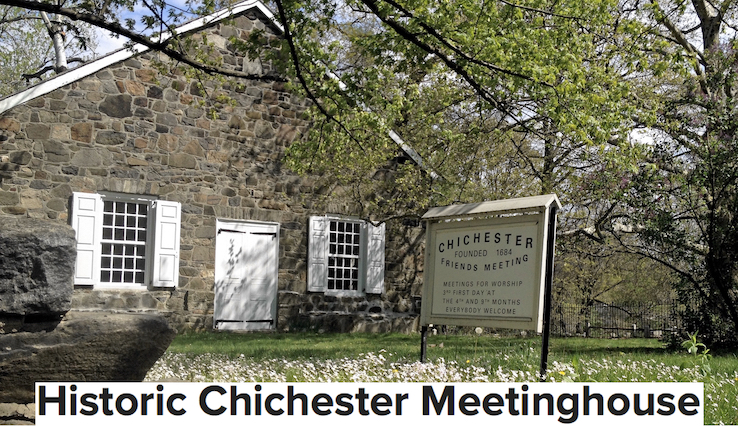Chichester Meetinghouse became the worship center for the group of Quaker immigrants who came to the area in the 1670’s, many years before William Penn received the grant for the land of Pennsylvania. When these Quakers arrived, the area was already inhabited by the Lenni Lenape Indian people and a hardy group of Swedish immigrants who peacefully traded with the Lenape, based in the community of Marcus Hook on the Delaware River.
Many of the Quakers were from the county of Sussex on the southern coast of England. They were fleeing the religious persecution their group suffered at the hands of the other Christian sects and authorities at that time. One of the prominent immigrants, William Clayton, had been imprisoned in a English (Sussex) jail in 1664 for attending a Quaker Meeting for Worship. Before he came to the New World in 1677, William Clayton was a member of the Chichester Friends Meeting in Sussex. First settling in Burlington, New Jersey, he eventually moved to the Marcus Hook area shortly afterwards and purchased 500 acres of land from Hans Olleson in 1679. (delco history p 456 ashmead). In June of 1682 it is recorded that the inhabitants of Marcus Hook petitioned the court to change the name of the area to Chichester which was approved. It is assumed that Clayton and his fellow Englishmen were responsible for the name change. Years later the name of Marcus Hook reverted to the town along the Delaware, but the area west retained the name of Chichester.
To hold religious services, the Quakers in Chichester first met in their respective homes. As the membership grew the Chichester Quakers needed a common worship building and in January 1688 approved raising funds from its members to build a meetinghouse. James Brown, who was married to Honour Clayton, William Clayton's daughter, "conveyed the two acres heretofore mentioned to William Clayton, Sr., Philip Roman, Robert Pyle, Jacob Chandler, Joseph Bushell, and John Kingsman, in behalf of and for the only use of the people of God called Quakers.” (delco history p 451 ashmead) It is believed that the first meetinghouse and an accompanying burial ground was built in 1689. By 1705 the acreage of the property had grown from two to seven acres.
The original meetinghouse was probably a modest wooden structure. The graveyard was for the first several decades unadorned with tombstones as the Quaker tradition at the time disavowed any ornamentation even after death. The original meetinghouse was destroyed by fire in 1768 and replaced with the stone building in 1769. The current structure remains as it was originally built with the exception of a privy and a small porch. No plumbing or electric wiring has ever been installed. Heat was provided by a corner fireplace and a central wood stove (which is still in operation).
In the late 1760’s Chichester Meeting came under scrutiny of Chester Quarterly Meeting, the larger Quaker organization in the area which among other administrative duties, dealt with matters of discipline. Attendance at the weekday meeting for worship had dropped off and an oversight committee was sent off to Chichester to investigate. In 1768, the committee records in its report they were concerned not only with attendance but also with the quality of their preparation of their business. Several months later another oversight committee sat in on their business meetings and reported similar findings. It was shortly afterwards their old meetinghouse burnt to the ground. They petitioned the Quarterly Meeting for help in building another meetinghouse but there was reluctance to assist. Although the community members (a major benefactor being one Richard Dutton) had raised funds to begin construction in 1769, those funds ran out before completion. Request for financial help went out to area Meetings but it would take almost two years before those contributions came in and the building completed in 1771.
With the new meetinghouse, the Chichester Quakers seemed to enjoy a new prosperity as the oversight committees from the Quarterly meeting stopped coming. During the Revolutionary War British war parties used the meetinghouse for target practice shooting randomly into the building. Musket ball holes are still visible in the front door. The community did survive the war but they were unable to survive a dramatic religious schism amongst Philadelphia area Quakers in 1827. This broke them into Hicksite Quakers (followers of Elias Hicks) who emphasized an “Inner Light and continuing revelation” theology, and Orthodox Quakers, who followed a more traditional Bible oriented theology. This split tore individual communities apart and precipitated movement of one or the other factions to completely new buildings. The present day meetinghouse came to house the Hicksite faction while the Orthodox Chichester Friends eventually built their own meetinghouse at present day Larkin Road and Chichester Avenue in 1831. The separation drained energy from both groups. The Orthodox Meeting was “laid down” in 1883. The Hicksite Meeting was able to hobble along to 1914 when it was officially laid down and its property transferred to Concord Monthly Meeting in Concordville about 7 miles to the west.
